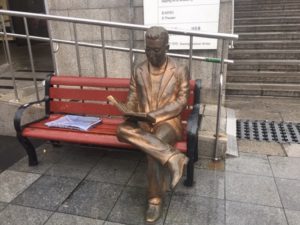Seoul, Korea
Friday 15 November 2019
For whatever reason, I found myself walking across the street from the Seamoonan Church, where a much better view was to be had. The photo gives an idea of this splendid architecture, but just as no printed photograph can capture the power of Van Gogh’s “Sunflowers,” no photograph can convey the beauty of this building. 
The time was spent at the Seoul Museum of History studying their impressive permanent photograph and video exhibit of the history of the city. The photos and history of the years between 1882 and 1905-1910 are of especial interest to my research and are fun and charming: photos of receptions at the foreign legations, elegantly dressed ladies in nineteenth-century finery and bearded gentlemen with tie and vest; Western diplomats and various officials, bearded and unsmiling; the interior of American homes and foreign legations with turn-of-the century palms and period furnishings—and scarcely a Korean in sight. But also photos of newly installed streetcars and Western-style buildings alongside single-story Korean shops in wide, dirt roads. And finally Koreans wearing round black eyeglasses, which were the rage at the time.
With the first arrival of the foreigners, particularly the Americans, who brought in the telegraph and the streetcar, electricity and newspapers, and the missionaries who were building schools and medical facilities, the time is good. But after 1905 and the signing with the Japanese of the Protectorate, it all becomes ugly. And uglier. After 1910, the Korean culture is steadily dismantled and the Korean people are peons in their own land, while the Japanese live the life of the conquering elite. Christians and nationalists, (the two regularly join forces) are targets for torture, imprisonment, and the most painful execution. 
So I happily resume study of nineteenth-century Korea, which is what “Korea 1908” is about anyway.
Raining again. It does not disturb this Korean, who continues his reading. Note that I use the pronoun “he” because it is a man who is reading. Sorry, ladies.


